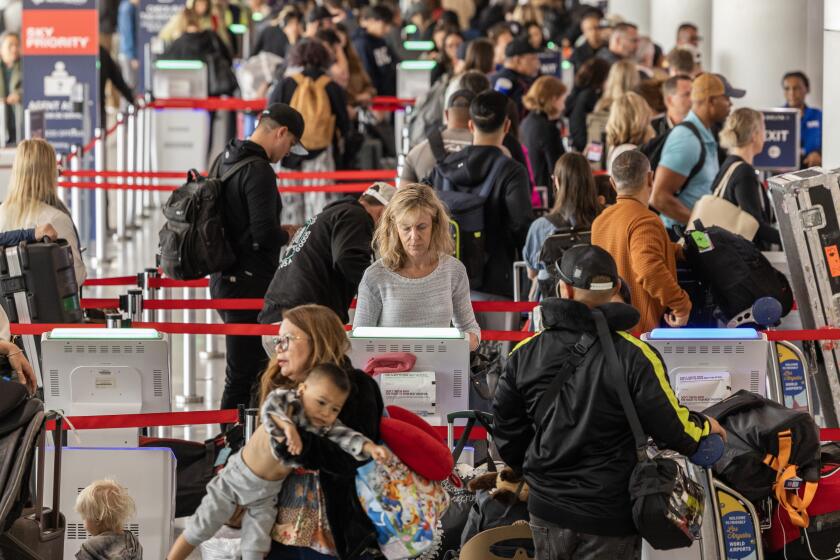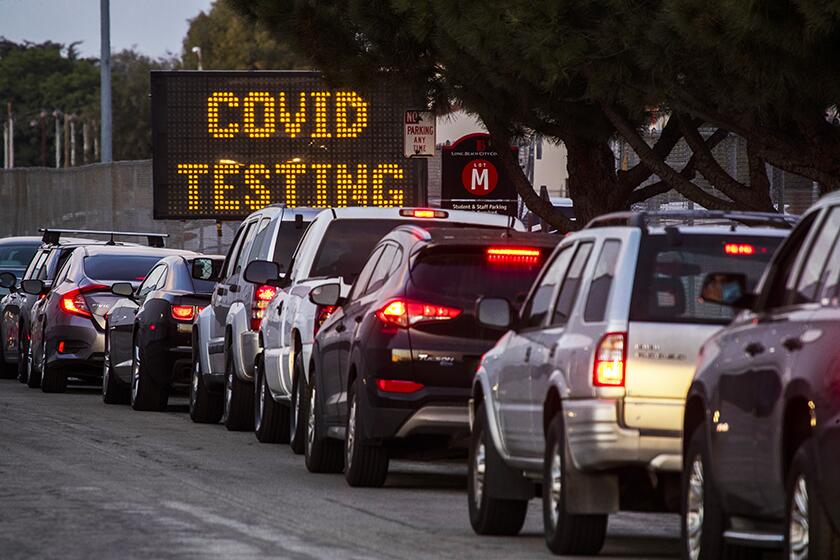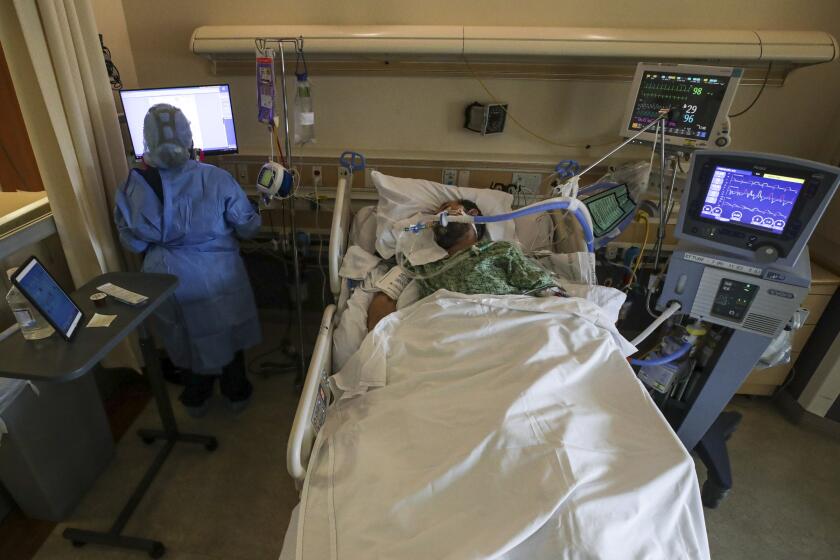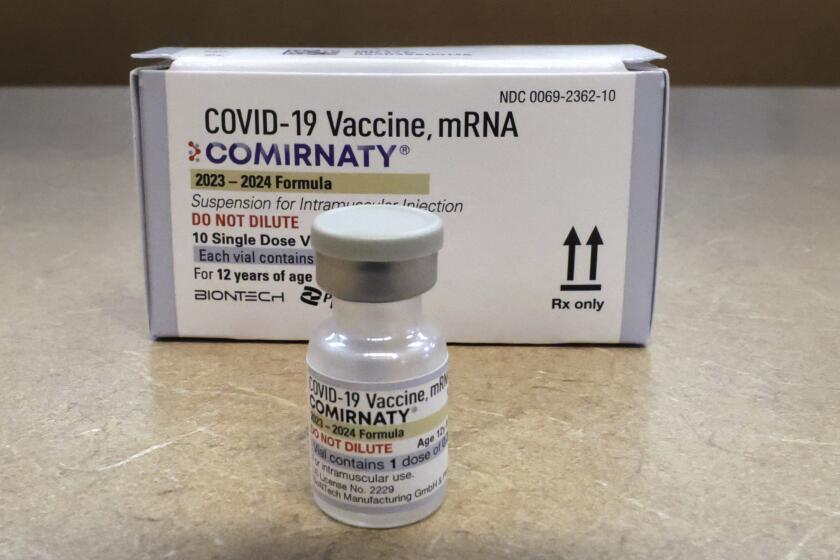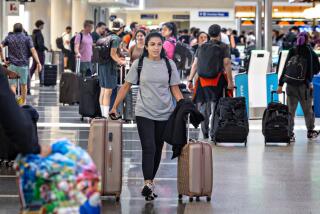L.A. County COVID cases, hospitalizations rise amid FLiRT variants summer uptick
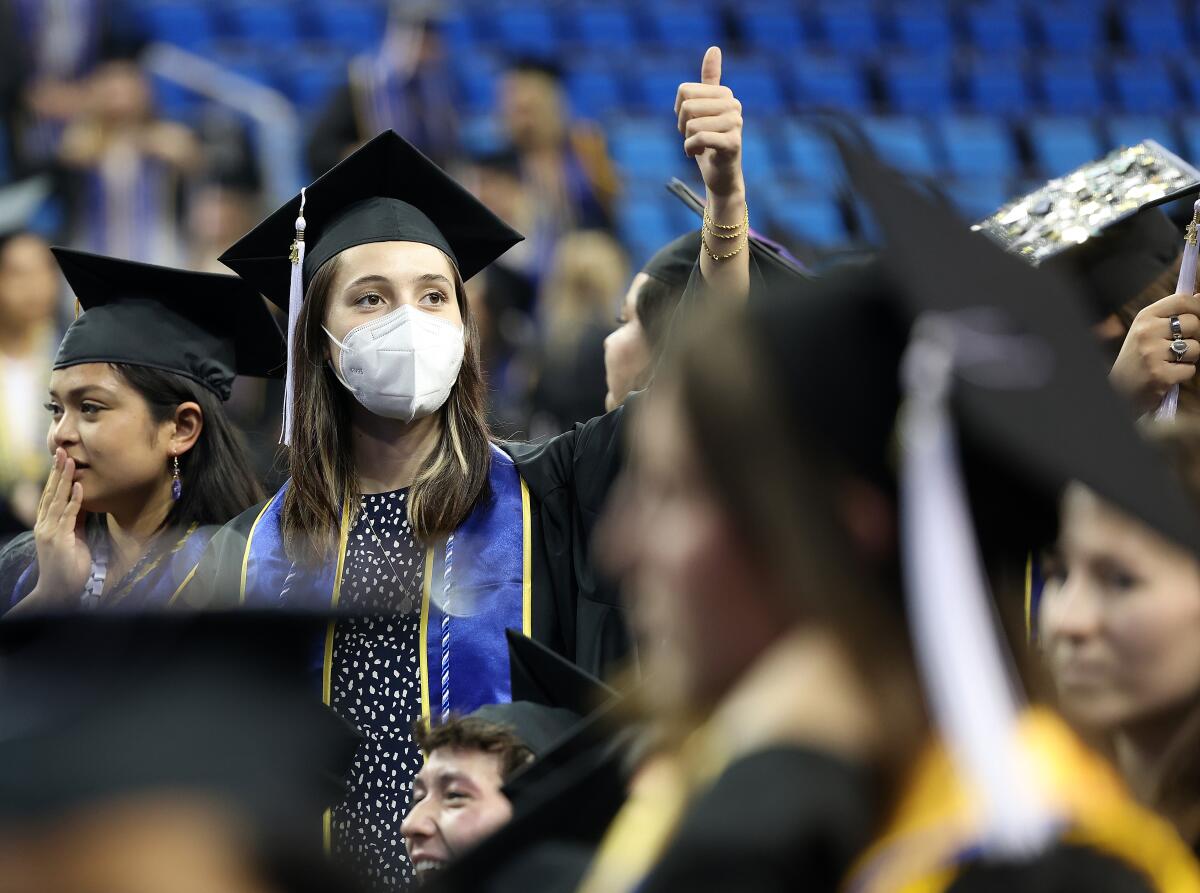
Los Angeles County’s COVID cases and hospitalizations are continuing to increase as a new subvariant of the coronavirus makes further gains across the state.
For the seven-day period that ended Sunday, there were an average of 121 new cases per day in L.A. County, up from 106 a day the prior week, according to the most recent data available.
Reported cases are certainly an undercount, as they generally measure only lab-confirmed infections where tests are done at medical facilities and not those who test at home or don’t test at all (and fewer people are testing now, officials say).
Scientists say the trends are an indication of an expected summer wave. A series of new COVID-19 subvariants, collectively nicknamed FLiRT, are increasingly edging out last winter’s dominant strain.
The new FLiRT subvariants, officially known as KP.3, KP.2 and KP.1.1, are believed to be roughly 20% more transmissible than their parent, JN.1, the winter’s dominant subvariant, said Dr. Peter Chin-Hong, an infectious-disease expert at UC San Francisco.
For the two-week period that ended June 8, 55% of estimated COVID specimens in the U.S. were of the FLiRT variants — up from 28.6% a month earlier.
Last summer’s peak in average new daily cases in L.A. County was 571, for the week that ended Aug. 30. Last winter’s peak was 621, for the week that ended Dec. 27.
Across California, COVID in wastewater has entered the high level, the first time since February.
COVID-positive hospitalizations also are trending upward. There were an average of 126 COVID patients in the hospital each day for the week that ended June 8, up from 102 the week before.
Still, the numbers of cases and hospitalizations are relatively low — even compared to the prior winter, which was relatively mild. Last summer’s peak for daily COVID hospitalizations was 620, and last winter, it was 825.
L.A. County’s uptick in cases and hospitalizations likely represents an earlier-than-normal start of the COVID wave, which has occurred every summer since the pandemic began. Previously, the mid-year COVID rise in cases and hospitalizations in the county began in early July — in 2021 and 2023 — but in 2022 it was in early May.
“This increase is not unexpected as we have seen increases in COVID-19 transmission during recent summers. We are not currently observing increases in COVID-associated deaths,” the L.A. County Department of Public Health said in a statement to The Times.
L.A. County is averaging about one COVID death per day.
COVID levels in L.A. County wastewater were at 13% of the winter 2022–23 peak for the week that ended June 1, about flat compared with the prior week.
But on a statewide level, California was one of six states with high levels of COVID in its wastewater, according to the U.S. Centers for Disease Control and Prevention.
Three states have even greater levels: Florida, Hawaii and Montana were designated as having very high COVID sewage levels. Besides California, the other five states with high levels were Alaska, Connecticut, Georgia, Maryland and New Mexico.
The rate at which COVID tests are coming back with positive results is continuing to rise. For the week that ended Monday, 6.4% of COVID tests in California came back with positive results, up from 2.4% the month before. Last summer’s peak was 13.1%.
Experts offered the following advice on what to do if you feel sick or test positive for COVID-19:
Stay home and away from others while sick
The CDC says people should stay away from others until at least 24 hours after their respiratory symptoms are getting better and they have not had a fever (and are not using fever-reducing medicine). Previously, the CDC suggested people with COVID isolate for at least five days and take additional precautions for a few more days.
In deciding when symptoms are getting better, what’s most important is “the overall sense of feeling better and the ability to resume activities,” the CDC says. A lingering cough can last beyond when someone is contagious, the CDC said.
The L.A. County Department of Public Health also recommends testing with a rapid test and getting a negative result before leaving isolation.
California may be headed to an earlier start to the summer COVID-19 season than normal as the latest family of coronavirus subvariants, FLiRT, has made significant gains nationally.
Test early, and often
An early cough or sore throat might not be just a cold; it can be COVID. So make sure to test, said Dr. Elizabeth Hudson, regional chief of infectious disease at Kaiser Permanente Southern California
And the first COVID test might be negative because the body hasn’t produced enough copies of the virus yet to show up on a test. So Hudson suggests testing once a day for three to five days if the first results are negative.
Doing so can help a person take measures to isolate and limit spread of the illness.
People with symptoms do not need to have tested positive for the coronavirus to be considered for a diagnosis of long COVID, a new report says.
Take additional precautions after you recover
People who have recovered from COVID-19 may still be contagious a few days after they have recovered. The CDC suggests taking added precautions for five additional days. They include:
- Wear a well-fitting mask
- Continue to test. If positive, it’s likely you’re more likely to infect others
- Keep your distance from other people
- Increase air circulation by opening windows, turn on air purifiers and gather outdoors if meeting with people
- Stick with enhanced hygiene — washing and sanitizing hands often, cleaning high-touch surfaces and covering coughs and sneezes
This past winter, the mortality rate for patients hospitalized with COVID-19 was 35% higher than for patients hospitalized with the flu.
Mask for 10 days
The L.A. County Department of Public Health says people with COVID-19 need to wear a well-fitting mask for 10 days after starting to feel sick — even if signs of illness are improving — to reduce the chance that other people could get infected.
Masks can be removed sooner if you have two consecutive negative test results at least one day apart, the agency says.
Be aware of COVID rebound
COVID rebound can occur when people feel better but then start to feel sick two to eight days later. Some people may also test positive again. COVID rebound can result in a person becoming infectious again and capable of infecting others.
Rebound can happen whether or not you take Paxlovid.
Officials say if you feel sick again after having recovered from COVID, go back to following the same instructions to stay away from others as you would during the first phase of the illness.
What to do if you test positive but have no symptoms
The CDC says if you never had any symptoms, but test positive, take additional precautions for the next five days, such as masking up, testing, increasing air circulation, keeping distance and washing hands often.
The L.A. County Department of Public Health recommends wearing a well-fitting mask for 10 days after testing positive for COVID-19. You can remove your mask sooner if you have two consecutive negative tests at least one day apart.
What to do if you are a close contact with someone with COVID-19
L.A. County health officials recommend that close contacts of people who have COVID-19 wear a well-fitting mask around other people for 10 days after their last exposure. And they suggest testing three to five days after their last exposure.
Federal health officials say U.S. adults 65 and older who got a shot of the updated COVID-19 vaccine in the fall should get a booster dose now, if at least four months have passed.
Protecting the elderly and immunocompromised
The L.A. County Department of Public Health urges infected people to avoid contact with older and immunocompromised people for at least 10 days after they started to feel sick or, if asymptomatic, after their first positive test.
If infected people are negative on two consecutive rapid tests, taken a day apart, the infected person’s risk of transmitting COVID to others is decreased significantly.
But to be especially safe around people at high risk, “masking or isolation [by the infected person] for the full 10 days would be the most protective way to further reduce that risk,” the agency said.
More to Read
Sign up for Essential California
The most important California stories and recommendations in your inbox every morning.
You may occasionally receive promotional content from the Los Angeles Times.

